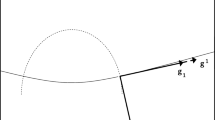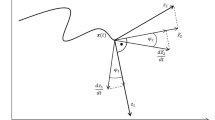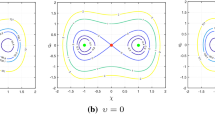Abstract
Based on the well-known methods of classical mechanics, the construction of dynamic equations for system using well-known constraint equations is associated with the accumulation of errors in the numerical solution and requires a certain modification to stabilize the constraints. The problem of constraint stabilization can be solved by changing the dynamic parameters of the system. It allows us to determine the Lagrange multipliers in the equations of motion and take into account possible deviations from the constraint equations. In systems with linear nonholonomic constraints, it is possible to express velocity projections in terms of the coordinate functions of the system. In this case, we can compose a system of second-order differential equations and present them in the form of Lagrange equations. Using the generalized Helmholtz conditions, one can compose the Lagrange equations with a dissipative function and ensure that the conditions for the stabilization of constraints are satisfied.
Similar content being viewed by others
References
J. Baumgarte, “Stabilization of Constraints and Integrals of Motion in Dynamical Systems,” Comp. Meth. App. Mech. Engng, No. 1, 1–16 (1972).
Sh. S. Nugmanova, “On Equations of Motion of Regulated Systems,” Trudy Kazan. Avia. Inst. 27, 26–35 (1953).
J. Wittenburg, Dynamics of Systems of Rigid Bodies (Nauka, Moscow, 1980) [in Russian].
F. Amirouche, Fundamentals of Multibody Dynamics: Theory and Applications (Boston: Birkh. User., Boston, 2006).
A.A. Burov and I.I. Kosenko, The Lagrange differential-algebraic equations Prikl. Mat. Mekh. 78(6), 818–832 (2014) [J. App. Math. Mech. (Engl. Transl.) 78(6), 587-598 (2014)].
R.A. Layton, Principles of Analytical System Dynamics (Springer, New York, 1998).
P. Meisser, O. Enge, H. Freudenberg, and G. Kielau, “Electromechanical Interactions in Multibody Systems Containing Electromechanical Drives,” Mult. Sys. Dyn., 1, 281–302 (1997).
F. Gonzales and J. Kovecses, “Use of Penalty Formulation in Dynamic Simulation and Analysis of Redundantly Constrained Multibody Systems,” Mult. Sys. Dyn. 29, 57–76 (2013).
U.M. Ascher, C. Hongsheng, L. R. Petzold, and S. Reich, “Stabilization of Constrained Mechanical Systems with DAEs and Invariant Manifolds,” J. Mech. Struct. Mach. 23, 135–158 (1995).
U. Ascher, H. Chin, and S. Reich, “Stabilization of DAEs and Invariant Manifolds,” Numer. Math. 67, 131–149 (1994).
U. Ascher, “Stabilization of Invariant of Discretized Differential Systems,” Num. Alg. 14(1), 1–24 (1997).
S.-T Lin, J.-Nan. Huang, “Numerical Integration of Multibody Mechanical Systems using Baumgarte's Constraint Stabilization Method,” J. Chin. Inst. Eng. 25(2), 243–252 (2002).
M. G. Bertrand, “Theoreme Relatife au Mouvement d'un Point Attire Vers un Centre Fixe,” Comp. Rend. 77 (16), 849–853 (1873).
M. G. Darboux, “Recherche de la Loi que Dois Suivre une Force Centrale pour que la Trajectoire Quellle Determine Soit Toujour une Conique,” Comp. Rend. 76(16), 760–762 (1877).
V. G. Imshenetskiy, “Determination of a Force that Moves a Material Point Along a Conical Section as a Function of its Coordinates,” Soob. Khark. Mat. Obch. 1, 5–15 (1879).
G. K. Suslov, Determination of the Power Function from Given Particular Integrals (Kiev, 1890) [in Russian].
N. E. Zhukovsky, “Definition of the Force Function from a Given Family of trajectories,” in. Complete Works (Gl. Red. Aviats. Lit., Moscow, Leningrad, 1937), Vol. 1, pp. 293–308 [in Russian].
T. Levi-Civita and U. Amaldi, Lezioni di Meccanica Razionale, Vol. 2. (Zabiuchelli, Bologna, 1927; Izd. Inostr. Lit, Moscow, 1952).
A. S. Galiullin, Methods of Solution of Inverse Problem of Dynamics (Nauka, Moscow, 1986) [in Russian].
G. Bozis and S. Ichtiaroglou, “Existence and Construction of Dynamical Systems Having a Prescribed Integral of Motion-an Inverse Problem,” Inver. Probl., No. 3, 213–227 (1987).
A. S. Galiullin, G.G. Gafarov, R. P. Malaishka, and A.M. Khwan, Analytical Dynamics of Helmholtz, Birkhoff and Nambu Systems (UFN, Moscow, 1997) [in Russian].
N. P. Yerugin, “Construction of the Entire Set of Systems of Differential Equations Having a Given Integral Curve,” Prikl. Mat. Mekh. 21 (6) 659–670 (1952).
R. G. Mukharlyamov, “On the Construction of Differential Equations of Optimal Motion on the Given Manifold,” Dif. Ur. 7(10), 1825–1834 (1971).
R. G. Mukharlyamov, “On the Construction of the Set of Systems of Differential Equations of Stable Motion on an Integral Manifold,” Dif. Ur. 5(4), 688–699 (1969)
J. Llibre and R. Ramirez, Inverse Problems of Ordinary Differential Equations and Applications (Springer International Publishing Switzerland, 2016).
R. G. Mukharlyamov, Differential-Algebraic Equations of Programmed Motions of Lagrangian Dynamical System,” Izv Ros. Akad. Nauk Mekh. Tv. Tela, No.4, 50–61 (2011) [Mech. Sol. (Engl. Transl.) 46(4), 534-543 (2011)].
R. G. Mukharlyamov, “Simulation of Control Processes, Stability and Stabilization of Systems with Program Constraints,” Izv. Ros. Akad. Nauk. Teor. Sis. Upr., No. 1, 15–28 (2015) [J. Comput. Syst. Sci. Int. (Engl. Transl.) 54(1), 13-26 (2015)]
H. Helmholtz, “Uber die Physikalische Bedeutung des Prinicips der Kleinsten Wirkung,” J. Rein. Ang. Math., No. 100, 137–166 (1887).
G. K. Suslov, “On the Kinetic Potential of Helmholtz,” Mat. Sborn. 19(1), 197–210 (1896).
A. Mayer, Die Existenbedingungen eines Kinetischen Potentials (Berl. Ges. Wiss., Leipzig, 1896).
G. Kielau, P. Maisser, “A Generalization of the Helmholtz Conditions for the Existence of a First-Order Lagrangian,” Z. Angew. Math. Mech. 86(9), 722–735 (2006).
Yu. I. Neimark and N.A. Fufaev, Dynamics of Nonholonomic Systems (pmNauka, Moscow}, 1967) [in Russian].
Acknowledgments
This study was financially supported by the RFBR (project 19-08-00261 A).
Author information
Authors and Affiliations
Corresponding author
Additional information
Russian Text © Author(s), 2019, published in Izvestiya Akademii Nauk, Mekhanika Tverdogo Tela, 2019, No. 3, pp. 124-135.
About this article
Cite this article
Kaspirovich, I.E., Mukharlyamov, R.G. On Constructing Dynamic Equations Methods with Allowance for Atabilization of Constraints. Mech. Solids 54, 589–597 (2019). https://doi.org/10.3103/S0025654419040137
Received:
Revised:
Accepted:
Published:
Issue Date:
DOI: https://doi.org/10.3103/S0025654419040137




